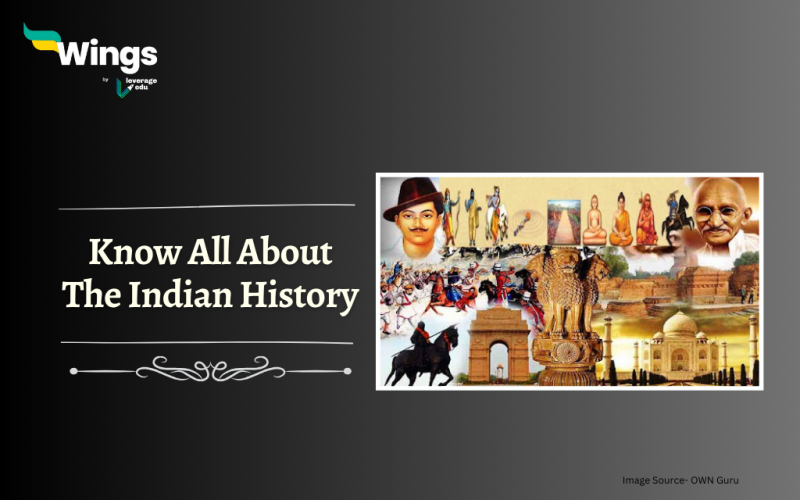India, the world’s most influential and oldest civilisation is the land of diversity and rich cultural heritage. The history of India dates back thousands of years ago. There has been evidence which shows the activities of Homo erectus nearly 20 lakh years ago and the habitation of Homo sapiens from nearly 73,000 to 55,000 years ago. From the ancient Indus Valley Civilization to the British colonial rule to India’s independence, India has witnessed a myriad of events that have curved its past and present. Join us on a journey through time as we delve into the exciting history of this enchanting land.
Table of Contents
| Timeline of Indian History | |
| 2700 – 1900 BCE | Indus Valley Civilization and Harappan Civilization flourishes |
| 1500- 200 BCE | Aryan Migration to India and the Vedic Period |
| 324 BCE | Foundation of Mauryan Empire |
| 300 BC – 300 AD | Sangam Age |
| 300- 800 AD | Gupta Empire rules over India |
| 700 AD | Different power struggles between dynasties. |
| 1526 | Mughal Dynasty establishment |
| 1757 | Battle of Plassey and British East India Company domination |
| 1857 | Sepoy Mutiny against British rule |
| 1947 | India gains independence from British rule |
Ancient Indian History
- Indus Valley Civilization (3300 – 1300 BCE):
- One of the world’s oldest civilisations, known for advanced urban planning, trade, and art.
- Cities like Mohenjo-Daro and the Harappan Civilization showcase sophisticated drainage systems and grid-like layouts.
- Deciphered scripts hint at a complex society with trade links to Mesopotamia.
- Vedic Period (1500 – 500 BCE):
- Rigveda, the oldest Vedic text, reflects early Hindu beliefs and practices.
- The emergence of rituals and philosophical debates in Upanishads.
- Panini’s grammar system and Ayurveda contributions make intellectual advancements.
- The Aryans migrated to India around 1500 BCE and laid the foundations of Hinduism and Vedic literature.
Also Read – What is the Aryan Invasion Theory?
- Maurya Empire (322 – 185 BCE):
- Chandragupta Maurya established the first centralized Mauryan Empire in India.
- Ashoka the Great embraced Buddhism, promoting peace and welfare through edicts.
- Decline post-Ashoka’s reign led to regional powers like the Gupta Empire.
Also Read – Post Mauryan Period: Kingdoms, Cultures & Administration
Other kingdoms like the Mahajanpadas, Nandas, Shungas, Satavahanas and Kushan Dynasties also thrived as rulers in different parts of India, leaving cultural and religious precedences for future generations in Indian history.
Medieval Indian History
The medieval period marks the existence of great kingdoms like –
- The Vakataka Empire
- Kamrupa Kingdom
- Pallavas
- Kadamba Empire,
- Harsha’s empire
- Chalukyas
- Rashtrakutas
- Gurjara- Pratihara Dynasty
Other empires like the Gahadavala Empire, Khayaravala Dynasty, Pala Dynasty, Cholas, etc
- The Gupta Empire (320 – 550 CE):
- Known as the Golden Age of India, the Gupta Empire (320-550 CE) witnessed advancements in art, science and literature.
- Samudragupta was named the title of Indian Napolean.
Also Read – Notes on the History of Medieval India
- Delhi Sultanate (1206 – 1526):
- Established in the 13th century, the Delhi Sultanate marked the beginning of Islamic rule in India.
- Muslim rulers like Qutb-ud-din Aibak established Islamic rule in North India.
- Tughlaq Dynasty’s administrative reforms and cultural syncretism.
- The Mughal Empire (1526 – 1857):
- The arrival of Babur, the first Mughal Emperor, heralded a new era of Indo-Islamic art and architecture in the Mughal Empire.
- This era saw the rise of powerful rulers like Akbar the Great, and Jahangir to Shah Jahan, who built iconic monuments such as the Taj Mahal.
- However, due to the arrival of the British East India Company in the 17th century, the empire saw its last Mughal Ruler, Bahadur Shah Zafar II.
Also Read – Complete Mughal Empire List: An Overview
- The Martha Empire (1674-1818):
- Founded by Chhatrapati Shivaji Maharaj, the Maratha Empire ruled in the 17th and 18th centuries.
- It reached its zenith in the 18th century but ended up getting defeated by Mughal Emperor Aurangzeb.
Colonial Era
- Portuguese, Dutch, French (15th – 18th century):
- Vasco da Gama’s arrival and establishment of trading posts by European powers.
- The Battle of Plassey (1757) marked the British East India Company’s dominance.
- Impact of colonialism on economy, society and culture leading to the Sepoy Mutiny (1857).
- Struggle for Independence (1857 – 1947):
- Contributions and Sacrifice of great leaders like Mahatma Gandhi, Subhas Chandra Bose, Bhagat Singh, etc
- Non-cooperation movements, Civil Disobedience, and the Quit India Movement.
- India gained independence from British rule on August 15, 1947. However, parts of India’s heartland were partitioned into India, Pakistan and Bangladesh.
Also Read – 20+ Greatest Indian Freedom Fighters and their Sacrifices
Post-Independence India
- Republic of India (1947 – present): Adoption of a democratic constitution, secularism, unity in diversity and federal structure.
- Economic Reforms: In the 1990s, India embarked on a path of economic liberalization, leading to rapid growth and development.
- Technological Advancements: India’s IT industry has surged ahead, making the country a global hub for technology and innovation.
- Cultural Influence: Indian cinema, music and cuisine have captivated audiences worldwide, showcasing the country’s rich cultural heritage.
From the ancient civilizations along the banks of the Indus River to the vibrant democracy of modern-day India, the country’s history is evidence of its resilience, diversity and spirit of unity in adversity.
Relevant Blogs
This blog was all about Indian history in a comprehensive manner. If you want to read more articles like this, you can get Short notes on the Modern History of India here. Also, you can visit our general knowledge page on Indian History!
 One app for all your study abroad needs
One app for all your study abroad needs













